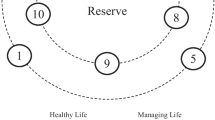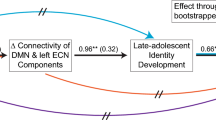Abstract
Young developed a Neo-Piagetian/Neo-Eriksonian lifespan developmental model that consists of 25 substages in cognitive and socioaffective development. The model includes five stages X five cyclically recurring substages that develop with respect to both cognitive (Neo-Piagetian) and socioaffective (Neo-Eriksonian) development. Here, the model is elaborated by expanding the substage component from five steps to six, through adding a preliminary perception/ perturbation step. The six-step sequence is described according to three dimensions within which they can be situated, borrowing from qubit quantum theoric modeling. The transition mechanism related to substage transitions in the cognitive Neo-Piagetian portion of the model is described according to catalytic function, as developed in RAF network theory. The transition mechanism is also workable according to the qubit quantum theoric model. However, further conceptualization is needed to represent mathematically the revised model according to these two models. The paper also expands on the adult stage of Collective Intelligence. Network theory is given prominence to allow for testable predictions of the model. The overall theory is named Integrative Constructivist Relational Adaptation, and is referred to as a supra-theory.

Similar content being viewed by others
Data Availability
N/A.
Data sharing not applicable to this article, as no datasets were generated or analyzed during the current study.
References
Aboulafia, A. L. T., & Dahl, M. (2019). Ground-breaking innovations in general psychology. Integrative Psychological and Behavioral Science, 53(2), 207–222. https://doi.org/10.1007/s12124-019-09493-4
Beyene, K., Aspden, T., & Sheridan, J. (2019). Using the behaviour change wheel to explore potential strategies for minimizing harms from non-recreational prescription medicine sharing. Research in Social and Administrative Pharmacy, 15(2), 130–144. doi: https://doi.org/10.1016/j.sapharm.2018.04.001
Borsboom, D., Deserno, M. K., Rhemtulla, M., Epskamp, S., Fried, E., McNally, I., Robinaugh, R. J., Perugini, D. J., Dalege, M., Costantini, J., Isvoranu, G., Wysocki, A. M., van Borkulo, A. C., van Bork, C. D., R., & Waldorp, L. J. (2021). Network analysis of multivariate data in psychological science. Nature Reviews Methods Primers, 1(1), 58. https://doi.org/10.1038/s43586-021-00055-w
Cabell, K. R., & Valsiner, J. (2014a). The catalyzing mind: beyond models of causality. Springer Science + Business Media.
Cabell, K. R., & Valsiner, J. (2014b). Systematic systemics: causality, catalysis, and developmental cybernetics. In K. R. Cabell, & J. Valsiner (Eds.), The catalyzing mind: beyond models of causality (pp. 3–13). Springer Science + Business Media.
Commons, M. L. (2008). Introduction to the model of hierarchical complexity and its relationship to postformal action. World Futures, 64(5–7), 305–320. https://doi.org/10.1080/02604020802301105
Dafermos, M. (2021). The metaphysics of psychology and a dialectical perspective. Theory and Psychology, 31(3), 355–374. https://doi.org/10.1177/0959354320975491
Demetriou, A., Makris, N., Spanoudis, G., Kazi, S., Shayer, M., & Kazali, E. (2018). Mapping the dimensions of general intelligence: an integrated differential-developmental theory. Human Development, 61(1), 4–42. https://doi.org/10.1159/000484450
Demetriou, A., Spanoudis, G., Christou, C., Greiff, S., Makris, N., Vainikainen, M. P., Golino, H., & Gonida, E. (2022). Cognitive and personality predictors of school performance from preschool to secondary school: an overarching model. Psychological Review. https://doi.org/10.1037/rev0000399 Advance online publication.
Erdös, P., & Rényi, A. (1960). On the evolution of random graphs. Publication of the Mathematical Institute of the Hungarian Academy of Sciences, 5, 17–61. Retrieved from http://snap.stanford.edu/class/cs224w-readings/erdos60random.pdf
Fried, E. I. (2020a). Lack of theory building and testing impedes progress in the factor and network literature. Psychological Inquiry, 31(4), 271–288. https://doi.org/10.1080/1047840X.2020.1853461
Fried, E. I. (2020b). Theories and models: what they are, what they are for, and what they are about. Psychological Inquiry, 31(4), 336–344. https://doi.org/10.1080/1047840X.2020.1854011
Gabora, L., Beckage, N. M., & Steel, M. (2022). An autocatalytic network model of conceptual change. Topics in Cognitive Science, 14(1), 163–188. https://doi.org/10.111/tops.12583.
Gabora, L., & Steel, M. (2020a). Modeling a cognitive transition at the origin of cultural evolution using autocatalytic networks. Cognitive Science, 44, e112878. https://doi.org/10.1111/cogs.12878
Gabora, L., & Steel, M. (2020b). A model of the transition to behavioural and cognitive modernity using reflexively autocatalytic networks. Journal of the Royal Society Interface, 17(171), 20200545. https://doi.org/10.1098/rsif.220.0545
Gaj, N. (2016). Unity and fragmentation in psychology: the philosophical and methodological roots of the discipline. London: Routledge.
Gopnik, A. (1988). Conceptual and semantic development as theory change: the case of object permanence. Mind & Language, 3(3), 197–216. https://doi.org/10.1111/j.1468-0017.1988.tb00143.x
Gopnik, A., & Wellman, H. M. (2012). Reconstructing constructivism: causal models, bayesian learning mechanisms, and the theory theory. Psychological Bulletin, 138(6), 1085–1108. https://doi.org/10.1037/a0028044
Henriques, G. (2011). A new unified theory of psychology. New York: Springer.
Hordijk, W., & Steel, M. (2015). Autocatalytic sets and boundaries. Journal of Systems Chemistry, 6(1), 1–5. https://doi.org/10.1186/s13322-014-0006-2
Hordijk, W., & Steel, M. (2016). Chasing the tail: the emergence of autocatalytic networks. Biosystems, 152, 1–10. https://doi.org/10.1016/j.biosystems.2016.12.002
Hutchins, E. (1995). Cognition in the wild. MIT Press.
Mascolo, M. F. (2021). Inching toward a unified metatheory for psychology. Integrative Psychology and Behavior Sciences, 55(1), 198–211. https://doi.org/10.1007/s12124-020-09543-2
Kauffman, S. A. (1993). The origins of order. Oxford University Press.
Kuhn, T. S. (1996). / 1962). The structure of scientific revolutions. University of Chicago Press.
Labouvie-Vief, G., Grühn, D., & Studer, J. (2010). Dynamic integration of emotion and cognition: equilibrium regulation in development and aging. In R. M. Lerner, M. E. Lamb, & A. M. Freund (Eds.), The handbook of life-span development: Vol. 2. Social and emotional development (pp. 351–370). Harvard University Press and the Chicago Academy of Sciences.
Lakatos, I. (1971). History of science and its rational reconstructions. In R. C. Buck, & R. S. Cohen (Eds.), P. S. A. 1970: in memory of Rudolf Carnap (pp. 91–136). D. Reidel.
Lakatos, I. (1978). Falsification and the methodology of scientific research programmes. In J. Worrall, & G. Currie (Eds.), The methodology of scientific research programmes: philiosophical papers (1 vol., pp. 8–93). Cambridge University Press.
Laudan, L. (1977). Progress and its problems: towards a theory of scientific growth. Routledge & Kegan Paul.
Laudan, L. (1984). Science and values: the aims of science and their role in scientific debate. University of California Press.
Michie, S., Johnston, M., Abraham, C., Rawton, R., Parker, D., Walker, A., & Psychological Theory Group. (2005). Making psychological theory useful for implementing evidence based practice: a consensus approach. BMJ Quality & Safety, 14(1), 26–33. doi: https://doi.org/10.1136/qshc.2004.011155
Oberauer, K., & Lewandowsky, S. (2019). Addressing the theory crisis in psychology. Psychonomic Bulletin & Review, 26(5), 1596–1618. https://doi.org/10.3758/s13423-019-01645-2
Osgood, C. E. (1969). On the whys and wherefores of E, P, and a. Journal of Personality and Social Psychology, 12(3), 194–199. https://doi.org/10.1037/h0027715
Overton, W. F. (2014). The process-relational paradigm and relational-developmental-systems metamodel as context. Research in Human Development, 11(4), 323–331. https://doi.org/10.1080/15427609.2014.971549
Piaget, J. (1954). The child’s construction of reality. New York: Basic Books.
Rindermann, H., & Ackermann, A. L. (2021). Piagetian tasks and psychometric intelligence: different or similar constructs. Psychological Reports, 124(6), 2795–2821. https://doi.org/10.1177/0033294120965876
Steel, M., Hordijk, W., & Xavier, J. C. (2019). Autocatalytic networks in biology: structural theory and algorithms. Journal of the Royal Society Interface, 16(151), 20180808. https://doi.org/10.1098/rsif.2018.0808
Surov, I. A. (2020). Quantum cognitive triad: semantic geometry of context representation. Foundations of Science, 26, 947–975. doi: https://doi.org/10.1007/s10699-020-09712-x
Surov, I. A. (2022). Natural code of subjective experience. Biosemiotics, 15(1), 109–139. https://doi.org/10.1007/s12304-022-09487-7.
Surov, I. A., Semenenko, E., Platonov, A. V., Bessmertny, I. A., Galofaro, F., Toffano, Z., Khrennikov, A. Y., & Alodjants, A. P. (2021). Quantum semantics of text perception. Scientific Reports, 11, 4193. https://doi.org/10.1038/s41598-021-83490-9
Teo, T. (2020). Theorizing in psychology: from the critique of a hyper-science to conceptualizing subjectivity. Theory & Psychology, 30(6), 759–767. https://doi.org/10.1177/0959354320930271
Węsierski, M. R. (2021). The manner of use, the uses and sub-uses of terms in social sciences: from the functional approach to natural language to applied semiotics and the philosophy of science. Semiotica, 240, 23–39. https://doi.org/10.1515/sem-2021-0019
Witherington, D. C., Overton, W. F., Lickliter, R., Marshall, P. J., & Narvaez, D. (2018). Metatheory and the primacy of conceptual analysis in developmental science. Human Development, 61, 181–198. https://doi.org/10.1159/000490160
Xavier, J. C., Hordijk, W., Kauffman, S., Steel, M., & Martin, W. F. (2020). Autocatalytic chemical networks at the origin of metabolism. Proceedings of the Royal Society of London, Series B: Biological Sciences, 287(1922), 20192377. https://doi.org/10.1098/rspb.2019.2377
Xu, F., Dewar, K., & Perfors, A. (2009). Induction, overhypotheses, and the shape bias: some arguments and evidence for rational constructivism. In B. M. Hood, & L. Santos (Eds.), The origins of object knowledge (pp. 263–284). New York: Oxford University Press.
Young, G. (2011). Development and causality: neo-piagetian perspectives. Springer Science + Business Media.
Young, G. (2012). A unitary Neo-Piagetian/ neo-eriksonian model of development: fundamental assumptions and meta-issues. New Ideas in Psychology, 30(2), 241–249. https://doi.org/10.1016/j.newideapsych.2011.11.002
Young, G. (2015). Causality in psychiatry: a hybrid symptom network construct model. Frontiers in Psychiatry, 6, 164. doi: https://doi.org/10.3389/fpsyt.2015.00164
Young, G. (2016). Unifying causality and psychology: being, brain and behavior. Springer International Publishing.
Young, G. (2019). Causality and development: neo-eriksonian perspectives. Springer International Publishing.
Young, G. (2022a). Causality and neo-stages in development: toward unifying psychology. Springer International Publishing.
Young, G. (2022b). An integrated Neo-Piagetian/ Neo-Eriksonian development and model I: Stages, substages, and mechanisms of change.Current Psychology.
Young, L. (2009). Textual analysis of “Paper Man” by Marguerite Andersen. Nouvelles Études Francophones, 24(1), 113–125. [« Analyse textuelle de “L’Homme-papier” de Marguerite Andersen ».].
Author information
Authors and Affiliations
Corresponding author
Ethics declarations
Competing interests
The author declares that he has no conflict of interest.
Ethics approval and consent to participate
N/A.
This is a theory paper.
Additional information
Publisher’s Note
Springer Nature remains neutral with regard to jurisdictional claims in published maps and institutional affiliations.
Rights and permissions
Springer Nature or its licensor (e.g. a society or other partner) holds exclusive rights to this article under a publishing agreement with the author(s) or other rightsholder(s); author self-archiving of the accepted manuscript version of this article is solely governed by the terms of such publishing agreement and applicable law.
About this article
Cite this article
Young, G. An integrated Neo-Piagetian/Neo-Eriksonian development model II: RAF, qubit, and supra-theory modeling. Curr Psychol 43, 449–464 (2024). https://doi.org/10.1007/s12144-022-04224-2
Received:
Revised:
Accepted:
Published:
Issue Date:
DOI: https://doi.org/10.1007/s12144-022-04224-2




